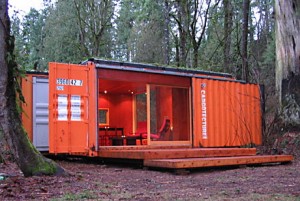Here at Shipping Discounts, we know it takes more than just fuel to help you ship. It takes quality customer service, great rates, and sometimes a little creativity.
Here are some other examples of creativity in shipping from around the world.
Shipping containers are being repurposed as prefabricated housing, offices, hotels, even shopping malls. It’s the ultimate green building material. You can see cool examples of “cargotecture” here.
And here, wood crates are the inspiration for a series of furniture by Jasper Morrison.
Speaking of creative repurposing, here is “Big Rig Jig,” a sculpture at the 2007 Burning Man festival in Nevada:

At Shipping Discounts, we are often asked about accessorial charges – what they are and how much they cost. Accessorial charges are charges made for performing freight services beyond normal pick up, transport, and delivery. These charges are usually billed as a flat fee. The following list includes common accessorial fees found on freight bills, yet is not fully comprehensive. These charges vary from carrier to carrier. Many of these fees may be included in the original freight quote, while some may not.
Lift gate – The use of a lift gate is necessary with heavy freight being loaded and unloaded in areas without a dock. See our blog post on lift gates.
Residential Pick Up/Delivery – Should the shipment need to be picked up or dropped off in a residential zone a fee will can be incurred.
Inside Pick Up/Delivery – Should the shipment need to picked up or dropped off inside of a location accessorial fees may be charged.
Waiting Time – When a driver experiences significant wait time for a shipment to be prepped or loaded a fee can be charged. This charge is based on the amount of time the driver had to wait.
Fuel Surcharges – Fuel surcharges can apply, especially for long hauls.
Storage Charges – If the shipment is stalled for any reason, or needs to sit with the carrier for a specific delivery date, a storage fee may be charged for taking up space on a dock or in a truck.
Notifications/Appointments – Charges can be incurred for notifying consignees of delivery.
Limited Access – This charge includes delivery points with limited access such as: schools, military bases, prisons, government buildings, etc.
Do Not Stack – This is a request on part of the shipper requesting that pallets or crates not be stacked on top of one another. This protects the goods while in transit, while also leaving more space in the trailer. The carrier cannot then fill the space with other shipments or goods.
Trade Show – Convention or trade show drop offs and deliveries can result in an extra fee.
Weekend Delivery – Weekend delivery is generally defined as a drop off occurring from 12am Saturday to 12am Monday.
Expedited Shipment – When needing a faster than normal shipment, fees will be charged.
Reconsignment - If while in transit, the vehicle is reconsigned to alternative location then the outbound rate per mile will be applied from point of original delivery to the new destination point.
Stop Offs – Stop offs are drop off points for the carrier to deliver portions of the load to multiple locations.

When the shipping or receiving address does not have a loading dock, manual loading and unloading is necessary. A lift gate is a platform at the back of certain trucks that can raise and lower a shipment by using a hydraulic system. The shipment can then move from the ground to the truck and vice versa. Lift gate service is typically used on freight exceeding 150 lbs in weight if a loading dock is not available at pick up or delivery.

The average cost of a lift-gate is $65. The price of needing a lift gate, however, can range from $30 to $120 depending on the carrier. Shipping Discounts has negotiated rates with several different carriers. Rates depend on the pick-up location, delivery location, and the delivery services requested. The best way to find your actual lift gate cost is to use the Transportation Management System provided to you through our website to quote your shipping costs with and without a lift gate.
When transporting large items, tailgate lifts enable you to keep the items level while being loaded and unloaded – working like an elevator. By eliminating the necessity for ramps, there’s a lot less risk of damage to the items being shipped. Lift gates were created for moving large and heavy items.
Lift gates create a huge increase in productivity when a loading dock is not present. Additionally, it eliminates the necessity of a forklift to assist in unloading heavy items. Essentially, lift gates were designed to reduce the requirement for physical manpower. Some larger objects carry substantial weight, and using a lift gate addresses numerous issues. These problems embrace the necessity for additional personnel, the danger of damaging things being loaded, and the risk of injury to one or many of your workers. The added efficiency and productivity justifies the cost added to the cost of shipping.
Contact us today about rates with and without lift gates.
Four types of trucks are commonly seen when shipping freight: Semi-Trailer Trucks, Box Trucks, Flatbed Trucks, and Refrigerator Trucks. At Shipping Discounts, we ordinarily ship freight in Semi-Trailer Trucks as most of our customers have LTL and FTL freight. Below are the types of trucks and their descriptions.
A semi-trailer truck is commonly known as a “semi” or an “18-wheeler”. These are the large freight trucks we see on the highway. The trailer has a set or several sets of wheels at the rear only, with the forward portion being supported by the truck tractor or towing vehicle. The placement of the wheels allows for the truck to make turns. The trailers on these trucks are typically 53 feet in length, however, shorter trailers do exist. Semi-trailers typically range from 40 feet to 53 feet. These trucks are generally used for FTL and LTL loads.

Box Truck:
A box truck has a separate, box-like cargo area that sits on a frame. Box trucks are generally used by companies that need to haul large items such as furniture, appliances, and large boxes. Box trucks come in all sizes. They can be seen on the road everyday as most moving companies use box trucks to transport furniture and household items.

Flatbed Truck:
A flatbed truck has an entirely flat, level body. The truck also lacks sides and a roof. This allows for quick and easy loading of goods. Consequently flatbed trucks are used to transport heavy loads that are not delicate or vulnerable to wet conditions, such as construction equipment, and also for abnormal loads that require more space than is available on a closed body.

Refrigerator Truck:
A refrigerator truck is designed to carry perishable freight at specific low temperatures. Refrigerator trucks can be ice-cooled, equipped with any one of a variety of mechanical refrigeration systems powered by small displacement diesel engines, or utilize carbon dioxide as a cooling agent. Most of the long-distance refrigerated transport by truck is done by trucks pulling refrigerated semi-trailers.





